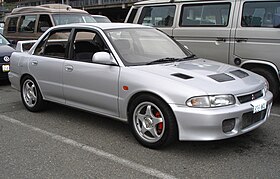Mitsubishi Lancer Evolution, also known as the
Lancer Evo,
Lan Evo, or
Evo,is a high performance
sports car manufactured by
Mitsubishi Motors that is based on the normal
Lancer. There have been ten official versions to date, and the designation of each model is most commonly a
Roman numeral. All use two litre,
turbocharged engines and
all-wheel drive systems.
The Evolution was originally intended only for Japanese markets, but demand on the
"grey import" market led the Evolution series to be offered through
Ralliart dealer
networks in the United Kingdom and in various European markets from
around 1998. Mitsubishi decided to export the eighth generation
Evolution to the United States in 2003 after witnessing the success
Subaru had in that market with their long-time direct rival, the
Subaru Impreza WRX STi.
Japanese-spec cars were limited by a
gentlemen's agreement
to advertise no more than 280 PS (206 kW; 276 hp), a mark already
reached by Evolution IV. Therefore, each subsequent version has
unofficially evolved above the advertised power figures, with the
Japanese-spec Evolution IX reaching an alleged output of around 321 PS
(236 kW; 317 hp). Various versions available in other markets,
particularly the UK, have official power outputs up to 446 PS (328 kW;
440 hp).
The tenth and final generation of the Lancer Evolution was launched in Japan 2007, and overseas markets in 2008.

| Production |
October 1992 – January 1994 |
|---|
| Body and chassis |
| Platform |
CD9A |
| Powertrain |
| Engine |
4G63t |
| Transmission |
5-speed manual |
| Dimensions |
| Wheelbase |
2,500 mm (98.4 in) |
| Length |
4,310 mm (169.7 in) |
| Width |
1,695 mm (66.7 in) |
| Height |
1,395 mm (54.9 in) |
| Curb weight |
1,170–1,240 kg (2,579–2,734 lb) |
Evolution I
The first Lancer Evolution used the 2.0 L turbocharged DOHC engine and AWD drivetrain from the original Galant VR-4 in a Lancer chassis, and was sold in GSR and RS models. This engine was also used in the Mitsubishi RVR with the Hyper Sports Gear trim package, and the Mitsubishi Chariot Resort Runner GT. The RS was a stripped-down version that lacked (power) windows and seats, anti-lock brakes,
a rear wiper, and had steel wheels to weigh approximately 70 kg
(154 lb) less than the 1,238 kg (2,729 lb) GSR, ready for racing or
tuning. The RS version was released with a mechanical plate type rear Limited-slip differential
(LSD). The GSR came with all of the conveniences of a typical street
car, including a digital screen climate control system. It came with
Mitsubishi's 4G63
engine producing 247 PS (182 kW; 244 hp) at 6000 rpm and 309 N·m
(228 lb·ft) at 3000 rpm. 5,000 of the first generation Evolutions were
sold between 1992 and 1993. Top speed was 228 km/hour (142 mph). The GSR
version of the Evolution I was the only Evolution Lancer released with a
viscous LSD rear differential. The subsequent Evolution Lancer models
all featured rear mechanical plate type LSD's.

1992 Evolution I
Flush
with success from its Galant VR-4 and hungry for WRC victory,
Mitsubishi determined in 1990 that further success would require a new
platform. To that end, Mitsubishi engineers started with VR-4’s proven
drivetrain and shoehorned it into the lighter, smaller Lancer chassis
and the Evolution I was born.
However, competition in
WRC’s Group A required the homologation of 2,500 production models. No
problem. Offered in GSR and RS flavors, 5,000 EVO Is were snapped up
between September 1992 and December 1993. Mitsubishi’s intent behind the
lightweight RS model was to provide a good starting point for building a
club-level rally car.
The Evolution I was introduced
in 1992 to compete in the World Rally Championship. It used the 2.0 L
turbocharged DOHC engine and 4WD drivetrain from the original Galant
VR-4 in a Lancer chassis, and was sold in GSR and RS models. The latter
was a stripped-down club racing version that lacked power windows and
seats, anti-lock brakes, a rear wiper, and had steel wheels to save
approximately 155 lb (70 kg) less than the 2730 lb (1238 kg) GSR, while
the former came with all of the conveniences of a typical street car. It
came with Mitsubishi’s 4G63 engine producing 247 PS (244 hp/182 kW) at
6000 rpm and 228 ft·lbf (309 N·m) at 3000 rpm, along with all wheel
drive which would become a trademark on all Evo models. 5,000 Evo Is
were sold between 1992 and 1993. Evo I was using the CD9A frame.





No comments:
Post a Comment